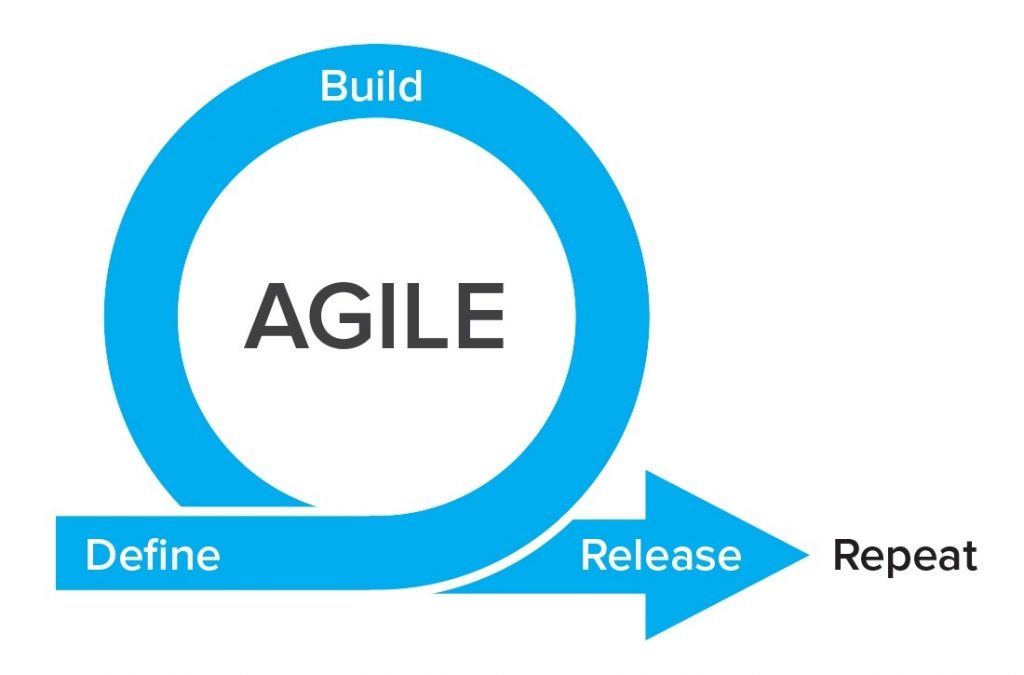Nearly every day, customer needs are different. Rampant technology advancement, heated competition, and a war for top talent have organizations looking to find ways to meet needs at faster paces with more delivery.
Enter the Agile Lifecycle Model, which emphasizes constant change and adjustment, breaking a project down into multiple stages and, in the end, delivering software more often, and more quickly.
Agile Project Management and the Agile Software Development Lifecycle
Project management used to be a much more predictive environment, with a project manager establishing a plan and ensuring the team adhered to it along the way. Release times were long, and customer feedback few and far between.
Today, this often doesn’t work well, as a completed software project with no check-ins could meet little to no requirements six months down the road. As a result, the <Agile software development cycle> has become increasingly popular, allowing in-house or outsourced software development teams to work in shorter cycles, called sprints, and develop much more iteratively.
Overall, the Agile cycle moves through a process, with each iteration, or workflow following a process:
- Requirements are defined
- The software is designed and developed based on the requirements
- Quality Assurance (QA) conducts tests, internal and external users are trained, and documentation is developed
- The iteration is moved to production
- Teams seek customer and stakeholder feedback to serve as the foundation for the next sprint’s requirements.
Of course, this process requires stakeholders to be available with feedback, team members must be able to collaborate frequently, and the software development must allow for flexibility.
While simply having a globally dispersed team doesn’t preclude the use of agile software development (and can, in fact, offer some benefits), organizations must consider the advantages and disadvantages of agile software development to ensure the methodology is a good organizational fit.
Agile Software Development Advantages
- A clear understanding of client and stakeholder visions. The iterative and collaborative approach in Agile allows multiple opportunities for development teams to understand a client’s needs. With a less iterative methodology, a client may be disappointed on the first unveiling of a product six months down the road. But with Agile, a client can give feedback to shape the second sprint, just a few weeks after the initial meeting.
- Greater transparency. Involving clients and stakeholders earlier – and often – in the development means they’re often exposed to working versions of the products, that aren’t always polished.
- Quick delivery. Sprints are scheduled every 1-4 weeks, putting new features and releases into the client’s hands quickly and regularly.
- Easily accommodates change. Short agile sprints grounded in user feedback allows software development teams to pivot quickly. This keeps the project focused on core needs, and allows teams to update or reprioritize as the business landscape shifts.
- Emphasizes quality. Each sprint includes a thorough QA process, including QA usability testing, enabling QA testing services to spot defects and mismatches early on in development.
- User-centric. The consistent emphasis on demo and user feedback ensures the final product addresses real-world challenges and meets user needs.
Agile Software Development Disadvantages
- Quantifying real scope can be a challenge. Developers may struggle to accurately quantify the true extent of development efforts, especially if projects are large. This highly variable unknown can frustrate teams, allow poor practices to fester, and even spur poor decision making, according to Inc.
- Extensive time commitments from everyone involved. More collaboration demands more time from everyone involved: developers, stakeholders, and clients. And in order for clients to provide tangible feedback, they may also have to invest time in training to learn the software as it is developed.
- Potential gaps in documentation. The iterative nature of agile work means software requirements are clarified just before development kicks off, making it easy to bypass thorough documentation. Without careful documentation, new team members may miss key details or feature requirements without historical knowledge.
- Endless or boundless work. Agile sprints depend upon pivoting based upon feedback, which means also entails pivoting the wrong direction if a customer’s feedback is unclear, or the developers misinterpret. Similarly, the project can easily suffer from scope creep adapting so quickly to feedback. Finally, an ever-refining product proves difficult for teams to declare fully finished, leaving the project to creep on endlessly.
- Resource allocation may be challenging. Developers who complete their work in a sprint can’t necessarily move on to the next project, because they may be needed soon for the next sprint.
Is Agile Right for Your Organization?
In some cases, like if a client must adhere to a strict schedule or has an inflexible budget, Agile may not be the best fit. But for businesses that merely need to cultivate an Agile mindset in order for the methodology to thrive, a skilled partner may be the perfect transition into the methodology. Some key practices to help Agile thrive include:
- Hold a daily meeting (often referred to as a stand-up meeting) to keep the team communicating and accountable
- Offer live demonstrations to demonstrate progress
- Share feedback with the entire team
- Commit to agility, and ensure your process changes based on feedback
TechGenies can help curb some of the disadvantages of Agile Software Development by building an on-demand software development team that flexes with your business needs and bringing our Genies’ Agile expertise to the table. Learn more today by visiting https://techgenies.com/services/ or contacting info@techgenies.com
Fill out the form and our team will be in touch with you promptly. Thank you for your interest!
info@techgenies.com
www.techgenies.com



